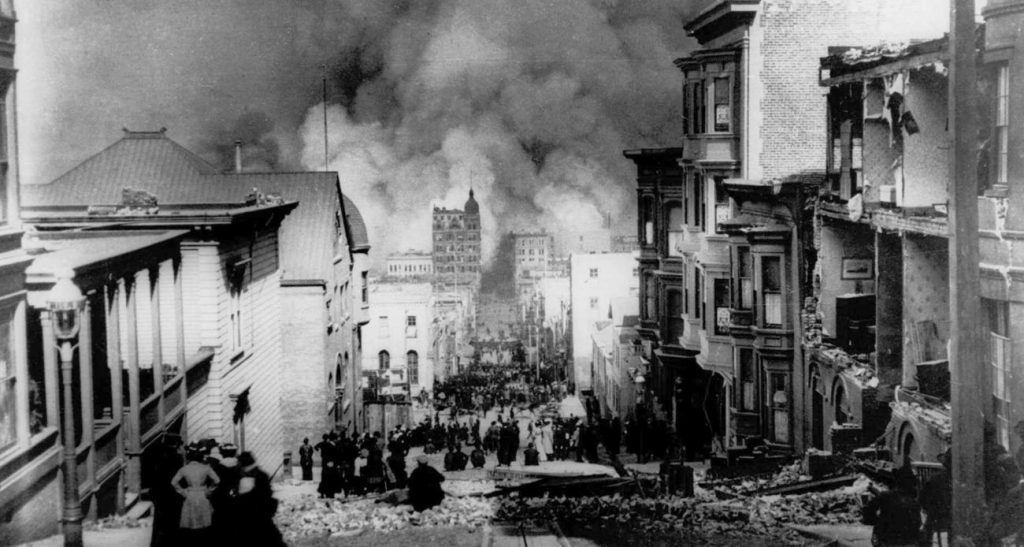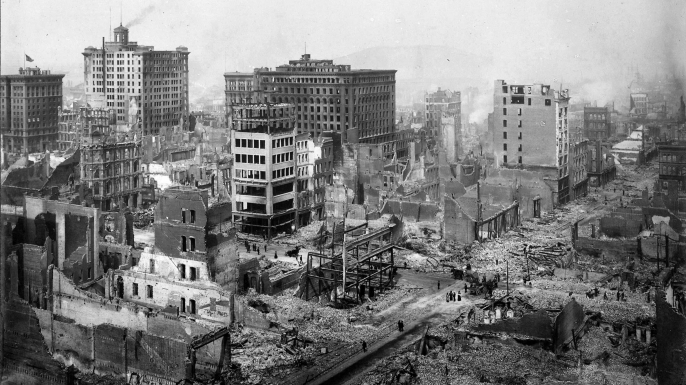On April 18, 1906, disaster struck Northern California at 5:12 a.m. when a huge earthquake hit. It was an estimated 7.8 on the moment magnitude scale. It was felt from Eureka down to Salinas Valley. Subsequently, huge fires broke out in San Francisco that would last for many more died. About 80% of the city was destroyed and 3,000 people died. The earthquake is one of the worst and deadliest natural disasters to occur in the U.S. The death toll is also the greatest of any Californian natural disaster.
7.8 on the moment magnitude scale is the most widely accepted estimate for the earthquake’s magnitude, though the exact number is unknown. Other estimates from 7.7 to 8.3 have been suggested. About two miles offshore from the city, the main shock epicenter occurred. It was felt all the way to Oregon down to Los Angeles and as far as Nevada. By about 20-25 seconds, a strong foreshock happened before the main shock, which lasted for about 42 second.
Shortly after the earthquake, they had reported 375 deaths. There were hundred of fatalities in Chinatown that went unrecorded. To this day, the number of casualties is still unknown, but it is estimated to be no less than 3,000. While most deaths were in San Francisco, 189 were reported in other places in the Bay Area such as Santa Rosa and San Jose. The Salinas River in Monterey County was permanently shifted due to the earthquake. It had diverted six miles to the south that was north of Marina instead of where it previously emptied between Moss Landing and Watsonville
More than half of the city’s population was left homeless afterwards. With a population of about 410,000, about 227,000-300,000 were without homes. About half of those evacuated across the bay to Oakland and Berkeley. Golden Gate Park, the Presidio, the Panhandle, and other beaches were covered with tens. Most refugee camps were still in use over two years after the disaster.
Over 80% of San Francisco was destroyed by the earthquake and subsequent fires. At the time it had been the financial, trade, and cultural center on the West Coast. However, the earthquake put a hold on this and Los Angeles instead took its place. The city was rebuilt quickly though.
The earthquake and aftershocks may have caused a lot of damage, but the fires caused even more. They began after the fire, burning out of control for days. An estimated 90% of the destruction of the whole disaster was from the fires. Over 30 fires destroyed about 490 blocks and 25,000 in the course of three days. A woman making breakfast for her family in their home on Hayes Street accidently started one of the largest fires. It late ron became known as the “Ham and Eggs Fire.” Some had started because firefighters were not properly trained with using dynamite. To create firebreaks, they had attempted to unsuccessfully demolish buildings in the city. For four days and nights, fires raged throughout San Francisco.
Some property owners purposely set fire to their buildings to claim insurance. This was because insurers in san Francisco covered fires, but not earthquakes. Others blamed most of the destruction on the fires.
The notable Palace Hotel had attracted many visitors, royalty and celebrities included. However, when it was burnt down in the fire, it was immediately rebuilt. Many scientific laboratories were also lost. The curator of botany at the San Francisco California Academy of Sciences, Alice Eastwood, has been credited for saving close to 1,500 specimens. Some of those specimens included a newly discovered and very rare species. Biochemist Benjamin R. Jacobs was researching the nutrition of everyday foods, but his laboratory and records were destroyed as well.
The fire cost about $350 million, which is equivalent to $8.97 billion today.
Soldiers patrolled the streets for the first few days after the disaster. They discouraged looting and the guarded building, the U.S. Mint, post office, and county jail included. They also assisted the fire department in demolishing buildings with dynamite. The army was in charge of feeding, sheltering, and clothing the tens of thousands of citizens affected by the disaster. On July 1, 1906, the army withdrew from the city when civil authorities assumed their responsibilities.
Mayor Eugene Schmitz issued an order on April 18 responding to the rioting and looting evacuees that “The Federal Troops, the members of the Regular Police Force and all Special Police Officer” were given permission to kill any looters.
Though the city had been completely destroyed, it was able to quickly recover. Citizens worked to rebuild the city and planners created a new and improved San Francisco. They rebuilt it with a more clean, logical, and elegant structure.



